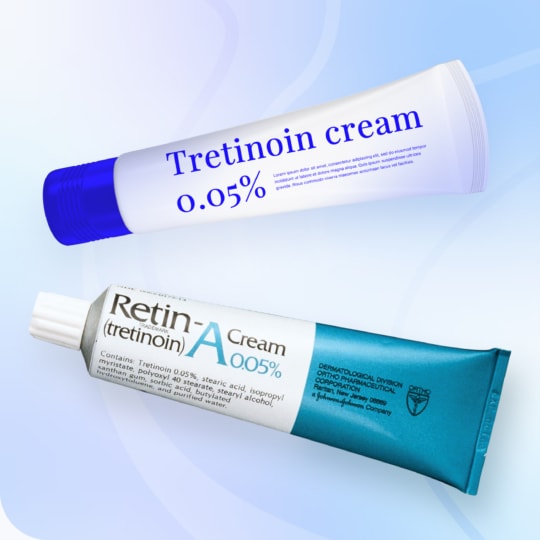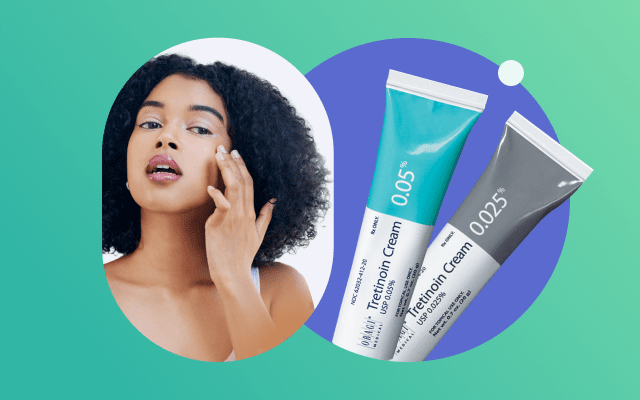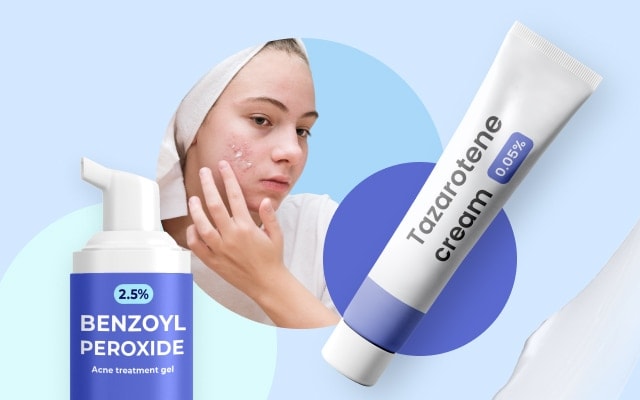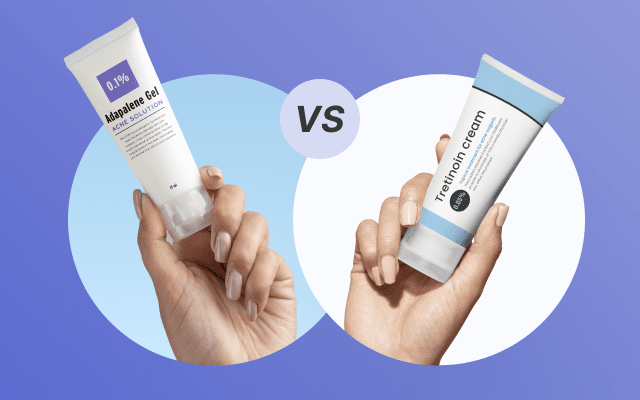Tretinoin strengths: Which % is right for acne, wrinkles, and sensitive skin?
Tretinoin is a popular treatment used to combat acne, photoaging and anti-aging, however there are different formulations and concentrations that’s why we asked a dermatologist about the different strengths of tretinoin.
Table of Content:
What is tretinoin? | How to get a prescription? | Common tretinoin strengths and formulations | Tretinoin strength chart | What tretinoin strength should I use? | How to start tretinoin safely | When to increase tretinoin strength | Is a higher tretinoin strength always better? | FAQ
Our commitment to producing high-quality content:
The information presented in this article is based on scientific research and the professional advice of our Content Medical Reviewers, who are experts in the field of Dermatology. How we write our content →
Article last updated November 2025.
Tretinoin is one of the most effective topical treatments for acne, fine lines, and photoaging. But not all formulations are created equal and choosing between 0.025%, 0.05%, or 0.1% can make a big difference in both results and irritation.
This guide, reviewed by Dr. Anna Chacon, board-certified dermatologist, explains tretinoin strengths, formulations, and how to select the right percentage for your skin type and goals.
What is tretinoin?
Tretinoin (all-trans retinoic acid) is a vitamin A derivative used to treat acne, fine lines, dark spots, and texture irregularities. It boosts cell turnover and collagen production, helping clear pores and smooth skin.
You can learn more about tretinoin in our comprehensive dermatologist guide.
How to get a prescription for the right tretinoin strength for my skin?
If you want to get a tretinoin prescription with a tretinoin strength that is right for you the best way to do it is by consulting a board-certified dermatologist, like Dr. Chacon, via Miiskin. Consultation is $59 and medication renewal visits are only $39, you get answer in 1-2 days.
You can explain your skin problem and what you want to use tretinoin for. You can also let the dermatologist know if you have used tretinoin in the past or if you are new to retinoids. With this information, together with the clinical questionnaire and your photos they will be able to write you a prescription with a tretinoin strength and formulation that is right for you.
You can also request a compounded tretinoin formulation if you want tretinoin to be blended with other ingredients.
Important Disclaimer: Compounded medications are not reviewed by the FDA for safety or efficacy.
Common tretinoin strengths and formulations
Tretinoin is available by prescription in several formulations:
- Creams – best for normal to dry or sensitive skin
- Gels – suited for oily or acne-prone skin
- Lotions or microsphere gels – offer slower release for better tolerance
Available tretinoin strengths
- Tretinoin 0.01% (very mild)
- Tretinoin 0.02%
- Tretinoin 0.025%
- Tretinoin 0.04%
- Tretinoin 0.05%
- Tretinoin 0.08%
- Tretinoin 0.1% (strongest)
Tretinoin strength chart
| Brand name | Formulation | Strengths | Best for | Irritation risk | Average price (US) |
| Altreno | Lotion | 0.05% | Dry or sensitive skin, mild acne | Low | $115 |
| Atralin | Gel | 0.05% | Oily or acne-prone skin | Medium | $150 |
| Avita | Gel | 0.025% | Beginners, sensitive skin | Low | $40 |
| Refissa | Cream | 0.05% | Aging skin, dry types | Medium | $100 |
| Renova | Cream | 0.02% | Fine lines, photoaging | Low | $270 |
| Retin-A | Cream / Gel | 0.01–0.1% | Acne, texture, wrinkles | High (at 0.1%) | $60 |
| Retin-A Micro | Gel | 0.04–0.1% | Moderate–severe acne | Low | $450 |
Dr. Chacon’s Tip: Lower strengths (0.01–0.025 %) are ideal for beginners or sensitive skin. Higher strengths (0.05–0.1 %) should be used under dermatologist supervision once tolerance is built.
What tretinoin strength should I use?
Dr. Chacon says you should always follow your dermatologist’s advice. For informational purposes only, she gives you some guidance on what tretinoin strength to use depending on your type of skin or the skin problem you want to address.
| Skin type / concern | Recommended strength | Notes |
| Sensitive / Dry | 0.01%–0.025% | Start low and use moisturizer “sandwich” method |
| Anti-aging / Fine lines | 0.025%–0.05% | Improves tone and elasticity |
| Oily / Combination | 0.05% | Balanced potency for acne and texture |
| Pigmentation / Texture | 0.05% | Combine with sunscreen & gentle exfoliants |
| Resistant / Severe acne | 0.1% | Only for advanced users |
How to start tretinoin safely
- Begin gradually – 2–3 nights per week, then increase.
- Use a pea-sized amount for the whole face.
- Moisturize before or after to minimize dryness.
- Always apply SPF 30+ daily.
- Expect mild flaking or redness for 2–4 weeks (“retinization” phase).
When to increase tretinoin strength
Dr. Chacon says you can consider moving up to the next strength after 3 – 4 months if:
- Your skin tolerates the current strength with minimal dryness
- Acne or fine lines are improving but not fully controlled
- Your dermatologist approves the change
Never jump directly from 0.025 % to 0.1 % without medical guidance.
Is a higher tretinoin strength always better?
Dr. Chacon says that a higher strength does not always mean better results. Think of tretinoin like going to the gym, you don’t start with the heaviest weights. You build up gradually so your skin strengthens over time.
Tretinoin works by gradually increasing skin cell turnover and collagen production. But when you jump to a higher concentration too soon, irritation can outweigh the benefits.
What happens when you use a tretinoin strength that is too high for your skin?
Dr. Chacon says that if you start with 0.05 % or 0.1 % before your skin is ready, you can experience:
- Intense peeling, redness, or burning
- Disrupted skin barrier (dryness, flaking, stinging)
- Increased sun sensitivity
- Less consistent use which slows down long-term results
Dr. Chacon says that even though 0.1 % tretinoin is the “strongest,” it doesn’t clear acne or smooth wrinkles faster if your skin can’t tolerate it. The most effective tretinoin strength is the one your skin can comfortably tolerate long-term.
Dr. Chacon recommends:
- 0.01 %–0.025 % for beginners or sensitive skin
- 0.05 % for intermediate users (a good balance between potency and tolerance)
- 0.1 % only for experienced users or those with severe acne, under supervision
It’s better to use 0.025 % consistently for 12 months than to give up 0.1 % after two weeks of irritation.
Provider & Prescription Information
Miiskin connects patients with independent dermatologists who provide care through their private practices. Compounded prescriptions can be ordered via Miiskin and are dispensed by Foothills pharmacy. Standard medications can be issued for any local pharmacy.
What tretinoin strength is best for wrinkles and anti-aging?
According to Dr. Chacon, most patients seeking anti-aging benefits achieve excellent results with tretinoin 0.025% to 0.05%. These mid-range strengths are strong enough to stimulate collagen production, improve skin texture, and reduce fine lines, while still being tolerable for long-term use. Higher concentrations like 0.1% can be more effective for deeply etched wrinkles but often cause more irritation, so gradual escalation under dermatologic supervision is ideal.
What tretinoin strength is best for acne?
Dr. Chacon explains that the best tretinoin strength for acne depends on severity and skin sensitivity. For most people starting treatment, 0.025% or 0.05% works well to reduce comedones, blackheads, and inflammatory acne while minimizing dryness. Those with more resistant or cystic acne may eventually benefit from 0.1%, though it is important to build tolerance first. A dermatologist may pair tretinoin with other acne medications such as benzoyl peroxide or topical antibiotics for optimal results.
Is Retin-A Micro 0.1% less irritating than “regular” Retin-A 0.1%?
Dr. Chacon confirms that Retin-A Micro 0.1% is generally less irritating than traditional Retin-A creams or gels of the same strength. The difference lies in its microsphere delivery technology, which releases tretinoin gradually over several hours instead of all at once. This controlled release minimizes peak irritation, redness, and peeling, making Retin-A Micro better tolerated for patients who are sensitive to standard tretinoin formulations.
Is Altreno lotion 0.05% less irritating than a “normal” tretinoin 0.05% cream?
Yes. Dr. Chacon notes that Altreno lotion 0.05% is formulated to be gentler than conventional tretinoin creams or gels at the same concentration. Its advanced lotion base includes hydrating ingredients like hyaluronic acid and glycerin, which help maintain the skin barrier and reduce dryness and flaking. As a result, Altreno offers a smoother, more elegant texture and is often preferred by patients with dry or sensitive skin.
What is the difference between tretinoin in a tube vs compounded tretinoin strengths?
Dr. Chacon explains that tretinoin in a branded tube, such as Retin-A or Altreno, contains standardized FDA-approved formulations with specific concentrations and ingredients. Compounded tretinoin, on the other hand, is custom-made by a pharmacy, allowing flexibility in strength or combinations, for example mixing tretinoin with niacinamide or azelaic acid. While compounding can be useful for personalization, it lacks the same FDA testing and consistency, so quality may vary between pharmacies.
What is best for severe acne: tretinoin 0.1% or isotretinoin (Accutane) pills?
For severe or cystic acne, Dr. Chacon emphasizes that oral isotretinoin, also known as Accutane, is usually the more effective treatment compared to even the strongest topical tretinoin 0.1%. Isotretinoin works systemically, shrinking oil glands and addressing acne at its root cause, while topical tretinoin primarily improves clogged pores and surface inflammation. However, isotretinoin carries more potential side effects and requires close monitoring by a dermatologist, making it suitable only for select patients.
Is the lowest strength of tretinoin (0.01%) more powerful than the most potent strength of retinol (0.1%)?
Dr. Chacon explains that even the lowest prescription strength of tretinoin, 0.01%, is still significantly stronger than over-the-counter retinol, even at 0.1%. This is because tretinoin is pure retinoic acid, which acts directly on skin receptors, whereas retinol must first convert into retinoic acid within the skin. This conversion makes retinol milder and slower-acting, but also better tolerated by beginners or those with sensitive skin.
Which is stronger, tazarotene 0.05% or tretinoin 0.05%?
Dr. Chacon explains that both tazarotene 0.05% and tretinoin 0.05% are highly effective retinoids, but tazarotene is considered the more potent molecule. Clinical studies show that tazarotene stimulates collagen production and reduces fine lines slightly faster and more noticeably than tretinoin at the same concentration. However, this increased potency often comes with more irritation, redness, and peeling, especially during the first few months of use. For patients with resilient skin or those already accustomed to retinoids, tazarotene 0.05% may deliver stronger results. For most individuals seeking a balance between efficacy and tolerability, tretinoin 0.05% remains the preferred choice for long-term anti-aging treatment.
What is more potent, tretinoin 0.1% or adapalene 0.3%?
Dr. Chacon explains that tretinoin 0.1% is generally considered more potent than adapalene 0.3% in terms of its overall retinoid activity on the skin. Tretinoin is pure retinoic acid, which directly binds to all three major retinoic acid receptors (RAR-α, RAR-β, and RAR-γ), giving it a broader and stronger biological effect on collagen production, cell turnover, and pigmentation.
Adapalene, while still a retinoid, is a third-generation synthetic analogue that primarily binds to the RAR-β and RAR-γ receptors, offering more targeted action with less irritation. Although adapalene 0.3% is more stable and causes fewer side effects, it typically produces milder anti-aging and textural changes compared to tretinoin 0.1%.
In summary, tretinoin 0.1% delivers stronger results but with a higher risk of dryness and peeling, while adapalene 0.3% provides gentler, more tolerable effects, especially suitable for sensitive or acne-prone skin.
All about tretinoin
Articles reviewed by board-certified dermatologists
The ultimate tretinoin guide by a board-certified dermatologist
What is the best tretinoin strength for my skin?
Can you use tretinoin if you have rosacea or sensitive skin?
How long does tretinoin take to work?
What is tretinoin 0.025% used for?
What is tretinoin 0.05% used for?
What is tretinoin 0.1% used for?
Research references:
https://www.ncbi.nlm.nih.gov/pmc/articles/PMC3225141/
https://www.ncbi.nlm.nih.gov/pmc/articles/PMC2699641/
https://jddonline.com/articles/40-years-of-topical-tretinoin-use-in-review-S1545961613P0638X
https://my.clevelandclinic.org/health/treatments/23293-retinol






 Want a prescription with the right tretinoin strength for you?
Want a prescription with the right tretinoin strength for you?